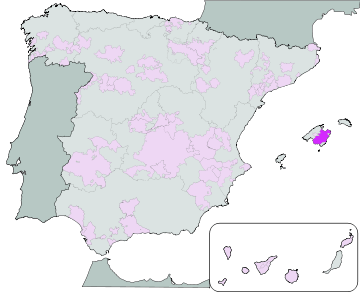Plà i Llevant (DO)

Plà i Llevant is a Spanish Denominación de Origen (DO) (Denominació d'Origen in Catalan) for wines located on the island of Majorca, Balearic Islands, Spain. The name in the Catalan or Majorcan language means "plain and east coast."
History
Grape growing and wine production was introduced to the island by the ancient Romans in the year 121 BC when Quintus Caecilius Metellus Pius took possession of the island for Rome. Pliny the Elder mentioned the wines of Majorca in his writings in the 1st century AD.
During the centuries of Moorish dominion, grape growing and wine production did not disappear despite the prohibitions of the Koran, as when King Jaume I conquered the island in 1230, he was offered top quality wine as a peace offering.
Before the arrival of the phylloxera plague at the end of the 19th century, there were about 27,000 ha (67,000 acres) under vines in Majorca and exports were 300,000 hl (8,000,000 gallons) of wine per year. After the devastation of the virus however, most of the vineyards were replaced by almond trees. In the late 20th century, there was a revival of the wine industry due to the demand for quality wine by tourists.
In 1991 the area was classified as Vinos de la Tierra, and, in 2001, 250 ha (620 acres) were upgraded to DO status.
Geography
The vineyards are located in the areas known as Felanitx and Manacor which cover the central and eastern part of the island.
They are at a rather low altitude, around 100 m (330 ft) above sea level.
Soils
The soils are quite fertile, have a high clay and limestone content and are on lime-bearing rocks (marl and dolomite). The drainage is good and allows deep penetration of the roots. The soils are generally either red in colour due to the presence of iron oxide, or white due to the clays, calcium carbonate and magnesium.
Climate
The climate is maritime Mediterranean, with long dry hot summers and short mild winters. In winter a strong wind is characteristic, especially on the plains, while there is not much risk of frosts or fog.
The average annual rainfall is 425 mm (17 inches), falling mainly in autumn is the form of violent storms.
Grapes
Recently, new varieties such as Macabeo, Parellada, Chardonnay, Tempranillo, Merlot and Monastrel have been imported from the mainland. The traditional island varieties include Prensal blanc, Callet, Fogoneu and Manto negro. The most commonly planted variety is Fogoneu.
The older vines are usually planted as low bushes (en vaso) whereas the newly planted vines are usually on trellises (en espaldera). The planting density is between 2,500 and 5,000 vines/ha (1,000 to 2,000 vines/acre).